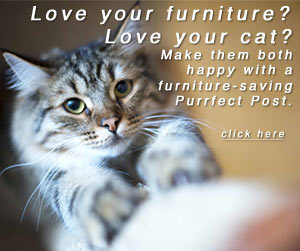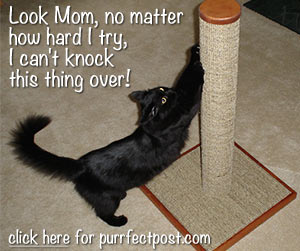Why Do Cats Stalk Things?

Your cat is staring intently at something in the distance. He hunkers down, his tail swishing back and forth ever-so-slightly. Then he rises, just a bit, and stalks forward in his crouched position, inching closer to the mouse toy that is bearing his intense scrutiny. You wonder to yourself: why do cats stalk things?
Stalking Is Part of Being a Cat
The answer to why cats stalk things is a fairly simple one on the surface: it's just part of being a cat. Fish swim, birds fly, and cats stalk things. They weren't always housecats, after all, and in the wild, cats hunt to survive. Stalking allows them to get closer to their prey before pouncing. This saves them time and much-needed energy, helping them to survive. Here are some interesting things about cat-stalking behavior:
- Cats stalk as part of their hunting routine. Stealthily tracking prey is an essential step in a cat's pursuit of food, and they are masterful at it.
- With their silent gait, laser-like focus, keen senses, and flexible body structure, cats are natural stalkers.
- All cats have the basic drive and skills to stalk and hunt, but they learn the nuances of its art from their mothers during kitten-hood.
Cats Need to Stalk, Even When They Get Their Food from a Bowl
In their well-appointed indoor homes, with food bowls and attentive humans, cats no longer need to hunt for their meals, but they still have a strong urge to stalk and pounce on prey-like objects. If this urge isn't satisfied, cats may become depressed, frustrated, or lethargic. Or they may set their sights—and claws—on human body parts to fulfill their innate desire to stalk. You may find that you're unable to walk through your home without having your ankles attacked by a furious feline ball of fur.
Interactive Play Satisfies a Cat's Desires to Stalk and Pounce
Daily interactive play lets your cat hone his stalking and hunting talents in ways that are acceptable to both of you. Interactive playing that focuses on simulated hunting scenarios may also offer additional advantages, such as:
- The exercise is good for your cat's physical and mental health and may help with weight management.
- Your cat can be creative during play sessions.
- Executing a series of successful "stalk, pounce, and capture" maneuvers is satisfying to cats; it reduces stress and may build confidence in shy and picked-on individuals.
- The relationship you have with your cat will be strengthened and enhanced by spending regular, positive interaction time together.
How to Help Your Cat Practice Stalking and Hunting Techniques
Your cat is predisposed to enjoy play-stalking and hunting, but there are many things that you can do that will improve the quality of the experience for him. Here are some tips to help you and your kitty get the most from daily "play with a purpose" sessions:
-
Use appropriate toys.
- Bring out a fresh toy. A toy on the floor is dead prey from a cat's perspective. A toy that comes out of nowhere is more lifelike and exciting.
- Small toys are the size of most of the prey that cats would go after outdoors.
- Wand toys are good choices for simulating the actions of birds flying and landing.
- Da Bird Wand Toy is a great one for simulating birds' movements for cats.
-
Manipulate the toys in ways that inspire your cat to go into stalking and hunting mode.
- Throw the toy away from your kitty, across his field of vision, not toward him. Prey flees predators or is unaware of them but doesn't run toward them.
- Make the toy move and act like prey. At various times the "prey" should be scared, fleeing, aware of your kitty's presence, aware that a cat is nearby, hiding, escaping, cunning, absent-minded, and so forth.
- Small movements may initially intrigue your kitty more than sweeping arcs will. Once you have your cat's attention, you can increase his interest by making the toy dart across the room at top speed.
- Use sound to enhance the stalk-and-hunt experience. For example, scrape a toy against the floor to get your cat's attention. Some toys come with squeakers that are activated by pressure. Cats are especially hard-wired to being interested in high-pitched sounds.
-
Create an environment that's conducive to hunting.
- Add props that your kitty can use strategically. For example, your cat will probably enjoy hiding behind a box or running through a tunnel to surprise the prey (and maybe a human or two). It's difficult for cats to be stealthy and execute their stalking maneuvers in an open area.
- Dim the lights to approximate dusk or dawn conditions; these are favorite hunting times for felines.
-
Balance challenge with ease of success (from your cat's point of view).
- Let your kitty "win" the hunting game a lot, but don't make the game too easy. The prey should be crafty and speedy but ultimately no match for the superior feline hunter.
- Let your cat get in some good pounces, and then let him do what he wants with the toy. He may paw at, grab it and kick it with his back feet, or carry it to another part of the house—that's all part of the fun.
- An ideal time to end the play session is after a decisive pounce and "kill." Alternatively, the prey can slither away, or "die" by becoming inactive.
- Start slowly and gently with play sessions if your cat is old, sick, or out of shape. If you are in doubt about the appropriate exercise level for your cat, consult with your veterinarian first.
- Learn your cat's playtime preferences, but also throw in some surprises.
Two More Great Benefits of Interactive Play-Stalking and Hunting
- The fact that you're a part of this important play activity strengthens the bond between you and your cat. Your kitty lets you be part of the hunt, even though—from his perspective, at least—you can't hunt.
- Because your cat's hunting urges will be satisfied during play-time, you'll be able to walk around the house in your bare or stocking feet without worrying that they'll be ambushed by a lightning-fast kitty coming out of nowhere. Well, at least most of the time.
You May Also Like These Articles:
Human-directed Aggression in Cats
What Does Catnip Do to Cats? Why Do Cats Like Catnip?
The Dangers of Strings, Ribbons, and Yarn for Cats
Notice: Ask-a-Vet is an affiliated service for those who wish to speak with a veterinary professional about their pet's specific condition. Initially, a bot will ask questions to determine the general nature of your concern. Then, you will be transferred to a human. There is a charge for the service if you choose to connect to a veterinarian. Ask-a-Vet is not manned by the staff or owners of CatHealth.com, and the advice given should not delay or replace a visit to your veterinarian.






